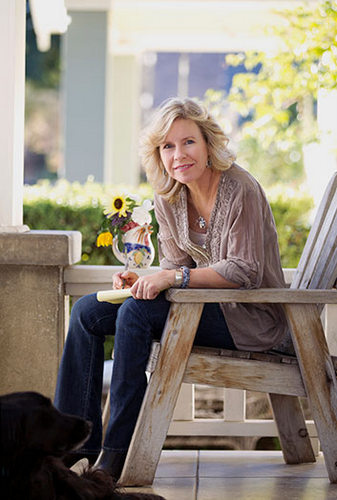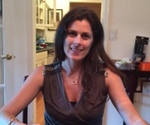Susan Straight, Author
I recently interviewed Susan Straight on the telephone. During the first session, my recording software failed just as my two-year-old son woke up howling from an unusually short nap. A tired and hungry toddler is like an escaped rhinoceros; I have not quite worked out the glitches of single motherhood. Graciously, Susan allowed me to reschedule, understanding first-hand the difficulties of being a single parent, a difficulty she never allowed to impede her aspirations and accomplishments. Based on our conversation, her fiction and essays, various speeches I found on YouTube, and the seminar she taught at Antioch’s Winter MFA residency, I was left with an impression of Susan’s clarity of purpose, as well as her no-nonsense perspective on hard work and dedication.
The award-winning author of eight novels, countless essays and short stories, Susan Straight is also a well-loved professor at UC Riverside’s MFA program in Creative Writing and Writing for the Performing Arts, which she co-founded. She was a finalist for the National Book Award for Highwire Moon and the Los Angeles Times Book Prize for A Million Nightingales. She has won the Edgar Award and the O. Henry Award for her short stories and was awarded a Guggenheim Fellowship, the Lannan Literary Award, and the Los Angeles Times Book Prize Robert Kirsch Award. Her stories have appeared in Zoetrope, McSweeneys, The Ontario Review, The Oxford American, The Sun, Black Clock, and others. Her essays have appeared in The New York Times, Reader’s Digest, Family Circle, Salon, Los Angeles Times, Harpers, The Nation, and other magazines. She was born, raised, and still resides in Riverside, California.
Diana Greenwood: This past December, you taught a seminar at Antioch entitled, “Is Regional Fiction Some of the Best in American Fiction?” where you stressed the importance of landscape in story. Can you speak to the function and importance of landscape in your novels?
Susan Straight: Some of the writers I brought up in the presentation, like Alistair Macleod who writes about Cape Breton and William Gay who writes about a small rural place in Tennessee, writers like us use landscape as a major character.
For me, the landscape of fictional Rio Seco but also just Southern California in general, that’s always a major character in anything I write. From the very beginning, when I was sixteen or seventeen and writing my first short stories, I wanted to write about the way pepper trees looked and the way their branches drooped. I described them variously as dusty rooster tails or if there’s a Santa Ana wind and you’re under a pepper tree, it feels like seaweed swaying all around you. Even the very last thing I wrote, which was an op-ed piece for the LA Times about the bookmobile, I went back to the pepper tree and realized that I’d been writing about the same landscape for my whole life. Everything from what blooms here, to how the ground looks at the end of August, to how the sky looks, that’s very important to my fiction.
DG: I have heard you say that two things, originally that there are two types of people: those who leave and those who stay, and then later, you added a third category—those who leave and come back. After toying with the idea of being a Brooklyn writer, you returned to Riverside. What is it about your childhood, your memories, and your life in Riverside that creates a need for storytelling?
SS: I wasn’t a Brooklyn writer because I didn’t even know what Brooklyn was back then. But when I was younger and read stories and novels set in New York City, I wanted to live someplace where there was a fire escape and tall buildings. I wanted to have an apartment and be able to sit out on the fire escape and read. That was my romantic vision of New York.
I was speaking at Rancho Los Alamitos, a historic place near Long Beach, and I was giving a talk. And a woman came up after me and she said there’s a third kind, “those who come back.” She had come back to Southern California after having been gone. We were trying to figure out if that made us sentimental or whether it made us losers.
For me, I left for USC and then I left for two years to go to Massachusetts for graduate school. When I was in Massachusetts, it was winter and it was twenty-seven below zero and there was snow. I still kept writing about palm trees and graffiti and chain-link fences and bougainvillea and realized again that the landscape of Riverside was what was calling me. But also I think I knew back then that no one else had really written about Riverside. People had written about inland Southern California. Laura Kalpakian writes about a fictional San Bernadino landscape and some people had written about the desert. But there was really no one who had written about a place like Riverside so that’s why I ended up doing it.
DG: Your novels illuminate communities, cultures, and people that exist in a very real sense in the United States, but that have often remained unexamined. As an author writing these intimate stories, some of which are culled from your own neighborhood, what is your responsibility in regard to the communities you are writing about?
SS: Since I still live in exactly the same place where I was born, I don’t know if I feel a responsibility about it. People tell me stories every day and I think it’s important for fiction to tell a good story. I’m telling stories about people for the most part no one hangs out with or no one ever hears about.
For example, a guy that came over this morning, Louie Lozano, who’s a Chicano guy born in Corona whose parents are from Mexico. I’ve known him for probably fifteen years. When we talk about old Corona or working in the lemon groves or my brother and his orange grove, he’s a natural storyteller. I don’t know if I feel responsibility towards anybody. Because he doesn’t care. He would never read anything I wrote anyway.
The responsibility is more to the reader to tell a great story that somebody is not going to put down. That’s the best way I can think of honoring a community is by making sure people actually read about them and don’t put the book down.
DG: To push that idea of community a little further, what sort of impact does what happened in Ferguson or is happening in Baltimore have on our artistic responsibility towards social justice? Does this affect you as a writer?
SS: Ferguson and Baltimore are examples that have gotten national attention. But as you know, we’ve been having police shootings and other shootings in Southern California for fifty years. I’ve been writing about that for my whole life. In fact, I published a story, “Angel Wings,” about a police shooting in 2010 that was just taught in Romania and Turkey and several other places. Because I just got an email from Romania, from someone who taught the story to her class and they were crying. There is plenty of social justice to write about here in our area. I haven’t thought about Ferguson and Baltimore because we have so much to write about here. I think I’ve written about twenty short stories and essays about black men and violence in this area.
DG: In an interview with the LA Times last year, you spoke about where you have written your novels: at a gas station counter, in cars, on your porch, on legal pads, and small notebooks. Many new writers are overly concerned with finding the perfect setting or time for writing. What advice do you give to your MFA students about getting over these limitations and fears?
SS: If you always have to wait for the muse to come, it’s going to take a long time. Especially if you have kids, you know how that goes. It’s good to be resilient and be able to write wherever you can and not to think about yourself and think about the imperative nature of the stories you want to tell.
If you look at professional basketball players or actors, they’re working all the time. Basketball players, they’ll play at the park, they’ll shoot free throws wherever. Actors and actresses are working all the time. Some of my best friends have always been hair stylists. It’s really funny. They’ll look at your hair wherever. When I’m in church, my friend, Tracy, will look at my hair and be like, “You need to come in tomorrow.” I’ll say, “I know.” And she’s like, “If you don’t come in pretty soon, I’m going to bring scissors to church. I’m just gonna do your hair here.” I always thought that was funny because writers, we’re workers like anyone else. Even though we are making art, it is funny to say I can only write at this time or I can only write under these conditions. I think a lot of people feel this way but I never have. I’ve been too desperate.
DG: In the same article, you dispel some misconceptions about being a mother and a writer, namely that we cannot find inspiration amidst the chaos of motherhood. You wrote in your car waiting for your girls’ practices to be over. Did you ever feel like you were not writing enough or getting enough on paper amidst all the time constraints of being a mother, a young mother, a single mother?
SS: I worked as hard as could and I had all these kids and I was teaching. I always wanted more time to write. That never changed. I never felt guilty that I wasn’t getting enough down on paper. I was writing pretty much every minute that I wasn’t with my kids or working. I didn’t watch a lot of TV during that time. I watch more TV now, that’s for sure. I published a novel every two years for a while. My last kid was born in 1995 and I published Highwire Moon in 2001. Then it was more like five years between books because the kids were in junior high and high school. They played a lot of sports and I did a lot of driving. But that was also a trilogy that just took more time to think about. I never feel guilt because I’m always working.
DG: Your Rio Seco trilogy began with the historical fiction, A Million Nightingales, then was followed by Take One Candle Light a Room, and ended with the prequel, Between Heaven and Here. It took fifteen years for you to complete these three books. Can you speak to the conception and development of this trilogy? How did you know when it was completed?
SS: Interestingly enough, it started out with several images: there was the young woman who was killed and her body left in a shopping cart; then this boy I met in my middle daughter’s kindergarten class, having seen cigarette burns on him; and then the woman I found during slavery. I found her by accident in the stacks at the UC Riverside library while looking for something else and there was a story about a mixed race slave woman named Manon Baldwin. She was freed after saving her master’s wife but she had to buy her son from him. Then she owned her son and couldn’t free him.
I had started the present day story about the woman killed in the alley and her body left in a shopping cart. Then I thought about the mothers. Somehow there was this relationship between the mothers and daughters that was based on a lot of sternness and fear because that had been passed down from slavery. And that’s why I ended up starting with A Million Nightingales. The idea of mothers and daughters separated when the daughter is sold away and then this daughter having to buy her own son. After that, I went back to Between Heaven and Here but I couldn’t quite finish it yet because I wasn’t sure about the son, the boy that had been burned.
So I ended up writing Take One Candle Light a Room, which is about Fantine, a travel writer. She was a little easier to focus on then and she’s the one who hears, “There’s two kinds of people, people who leave and people who stay.” She hears that from her own mother. So I was still trying to write about mothers and daughters and that relationship, which is: we want you to stay home yet we want you to be successful. But there are some mothers that just want you to stay home and that was Fantine’s mom. I was finally able to come back at the very end and finish Between Heaven and Here.
I still am writing about Victor. He shows up in a book I’m working on right now. So I don’t know that I’m done. I’ve finished that trilogy which is about that family. But the one character who is still showing up now and then is Victor and a little bit of Glorette.
DG: What are you working on now?
SS: I’m finishing a novel that’s set in Prince Edward Island, which is a completely different landscape. Maritime Canada, that’s the landscape of my stepdad. I’m finishing that now. There’s a section that takes place in Southern California and Victor is in that. But this one is in the land of Anne of Green Gables. And it’s two cousins whose mothers were sisters and their mothers both left the island. So it’s also about leaving and staying home.
Then the other project I have is a group of linked short stories all set around different freeways of Southern California. That’s called Take the Golden State. I just finished two more of the stories in that one. I think there are ten stories in that now. Maybe two more to go.
DG: A lot of your characters range in ethnicity, age, class, education, time period, and even to a certain extent, geographical location. How do you approach writing these varied voices?
SS: It’s just all fun. They are all great voices. Like you said, everything from Louie Lozano telling his story, to me meeting somebody down on the river bottom and while I’m walking the talk, they tell me the story of their life. As long as it’s an interesting story in a distinctive voice, I think they’re all fun. I guess I don’t ever think about myself. I just think how to tell the story right so it doesn’t bother me if they’re all different. Although I don’t know much about rich people, I will confess.
DG: What does a recommended reading list look like in one of your classes?
SS: That depends on what class it is. I teach seminars for graduate students. I teach the mixed race novel class for three hundred undergraduates. For that, we do books with narrators who are mixed race. So we’ve done Wingshooters, by Nina Revoyr, Girl Who Fell From The Sky, by Heidi Durrow, Everything I’ve Never Told You, by Celeste Ng, and Highwire Moon, which is mine. So that’s four books with young mixed race narrators.
I’ve taught a class called “Road Trip Novels.” And then we did Winter’s Bone by Daniel Woodrell. We did Autobiography of Miss Jane Pittman by Ernest J. Gaines. We did Under the Feet of Jesus by Helena Maria Viramontesand we did Cormac McCarthy’s The Road.
DG: Obviously your students learn a great deal from you. What have you learned from them?
SS: They tell great stories. I just had a publishing roundtable at UCR last week. I had two agents and two editors come and talk about the business of publishing and the way it works and what they’re interesting in. I had two alumni come. One is Minh Pham. He finished a memoir about growing up as the immigrant son of a Vietnamese woman who works in a nail salon. His essays are about what it’s like to grow up in this landscape of the nail salon, which is a hidden landscape in America.
Then I have another student, Paula Tang, who is half Korean and half Chinese. She’s almost done with this really funny collection of stories about growing up in this small mostly white community where there’s only one Chinese restaurant. And how all the people only want specific Chinese food that has nothing to do with the character who knows how to cook. With my students, there’s always a joy in hearing a different story that no one has ever told before. I never get tired of that.
DG: Thank you, I appreciate your time.
SS: Well, hang in there with the kids.
DG: I have two and I’m a single mom now so it’s a bit nuts. But it is funny how the less time I have the more I’ve actually gotten done. It’s sort of what you talk about—a bit of a misconception. But I think a lot of young writers are paralyzed by those fears. I really appreciate what you’ve shared, in the seminar and the articles I’ve read, about your experience being a mother and working writer.
SS: Isn’t it funny? Whether someone’s a painter or anything else, you always hear about someone who is just morosely sitting around waiting for that moment to come. But I don’t think we have that luxury when we are single parents, when we are parents at all, but especially single parents.
And it’s not about whether trying to earn money either, it’s more like, “What are you going to leave behind in the world?” I would always say I want to leave behind three great kids and a bunch of great books. So if that’s what I want to leave behind, then there’s way less time to sit around feeling sorry for myself. But it’s true there’s less shopping. I don’t even care about clothes. I just wear whatever I wear. I don’t care so much about how my house looks or my car or any of that stuff. That’s the stuff that’s less important to me. But every single moment that I could be reading and writing, that’s what I want to do.






